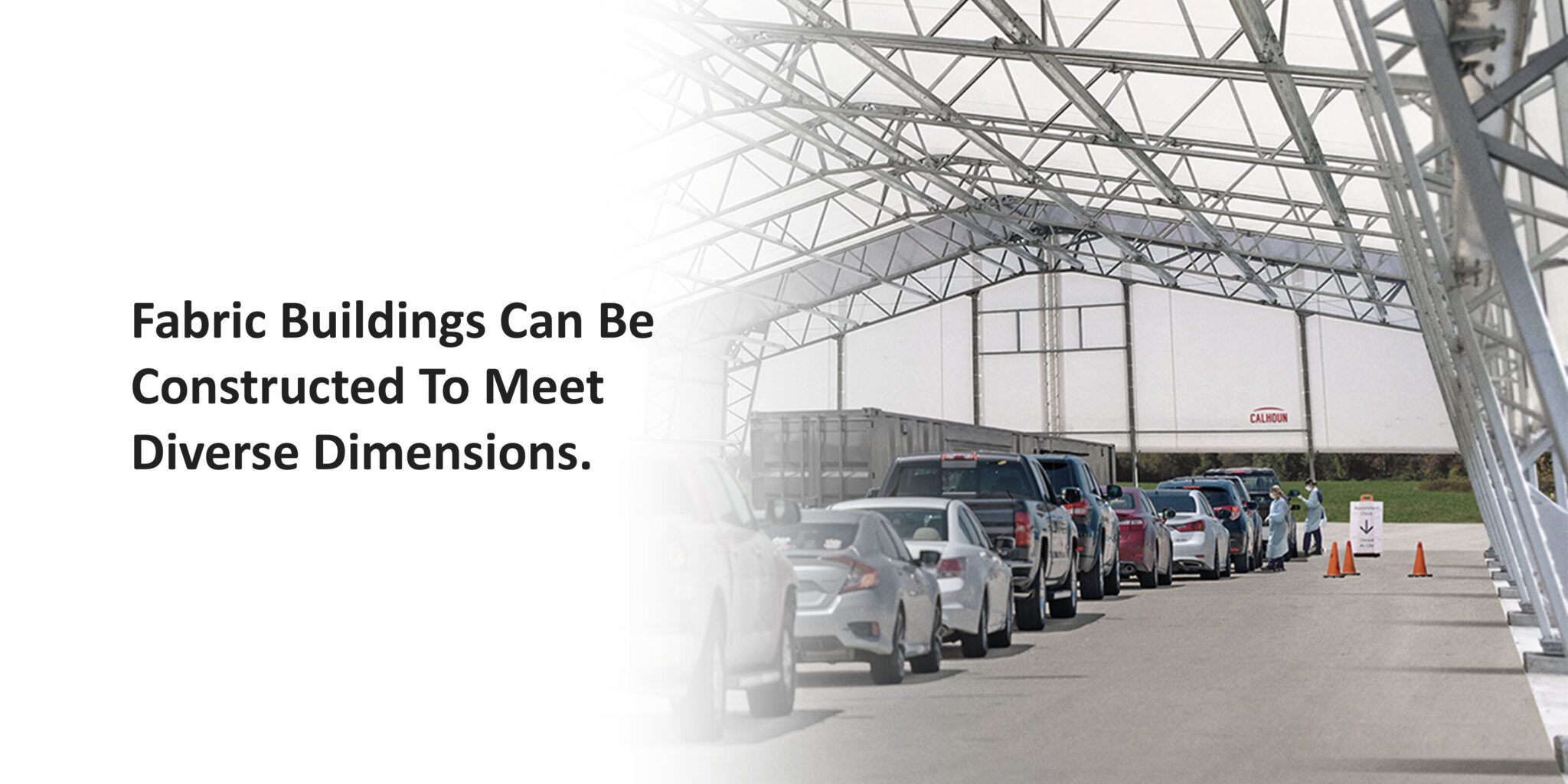What Is Polyethylene Fabric?
by Admin | Dec 17, 2021

At Calhoun, we understand the properties of polyethylene (PE) fabric. Other fabric structure companies may fail to fully comprehend the mechanics of a PE fabric building, which usually leads to premature repairs and replacements. Calhoun uses a specialized approach that prevents the tension fabric membranes from weakening or breaking down sooner than expected.
Before a fabric structure is designed and installed, it is essential to understand how polyethylene fabric behaves as a building material. Let’s review what PE material is and how Calhoun uses it to build fabric structures that benefit you.
What Is PE Fabric?
Polyethylene fabric is a lighter type of architectural fabric consisting of a woven scrim protected between two outer layers of plasticized coating. These coatings contain helpful protectants to last the life of your building — a lifespan that generally ranges decades. Fungicide-resistant fabrics prevent mold growth in humid or rainy climates, while ultraviolet stabilizers keep the fabric from fading or breaking down under the sun’s intense rays. A flame-retardant coating is also available.
Before PE fabric was introduced to the fabric-covered building industry, the overstressing of tension fabric membranes posed a major issue during manufacturing and installation. Polyethylene fabric performs well when the material is subjected to proper tension both horizontally and vertically. If the structure is shaped using a nonlinear analysis, the fabric should not move under pressure from the various environmental loads applied. PE fabric also has a lower initial price than heavier architectural fabrics.
What Is HDPE Fabric?
High-density polyethylene (HDPE) fabric gives structures more flexibility than other common types of polyethylene. From a chemical standpoint, the higher density is caused by less branching in the fabric’s molecular composition. This understanding translates to stronger molecular forces in the tension fabric membranes and a sizeable strength-to-density ratio. The HDPE fabric can provide increased protection against abrasion during the manufacturing or installation processes.
Calhoun currently uses engineered HDPE fabric as a primary building material for a wide array of projects. The HDPE fabric can resist the wear of everyday use and stands up against harsh weather elements, ensuring a longer-lasting fabric structure.
Polyethylene Fabric as a Building Material
Architectural fabric is constructed to outlast other building materials. Conventional materials like steel and concrete cannot offer the same unique advantages as PE fabric.
Heavier architectural fabrics typically have higher initial costs and are more challenging to shape into the desired structure. That’s why lightweight polyethylene fabric is a strong, durable and more reliable choice for your building material. Quality certifications such as ISO 9001 and CSA A660 will help to ensure that the fabric structure company is following or exceeding current accepted manufacturing standards.

Total Fabric Building Design Flexibility
With Calhoun fabric structures, you can have total design flexibility on your new building. The HDPE fabric makes it easy to design and install highly customized fabric structures that would ordinarily be too challenging or time-consuming for traditional methods.
Fabric buildings can be constructed to meet diverse dimensions with varying column sizes, peak heights and roof pitches. Vast customization options include canopies, lean-tos, offset peaks and mono-slope roofs. Your design may even contain added structural elements such as heating or cooling systems, hangar doors, cranes, conveyors, fire suppression systems and heavy lighting equipment.
In addition to customizing the structural design of your building, you can also choose from several fabric colors to suit your needs. The variety of colors enables you to enhance branding or proudly display the company’s logo. Fabric building covers do not require nails or screws, which could create damaging entry points for water. Both the Bag Cover System and Keder Panel System from Calhoun Super Structure are designed to prevent moisture from entering the building. All steel supports are welded and hot-dip galvanized to further protect against corrosion and rust for a stronger design that will last a long time.
Are PE Fabric Buildings Worth It?
Polyethylene fabric buildings provide numerous advantages over conventional steel, wood and concrete structures.
When it comes to expanding a building or other structure, traditional materials typically pose more significant challenges than fabric. PE fabric makes installation much faster, improving the efficiency of both permanent and temporary fabric-covered buildings. While fabric structures are usually permanent, a portable design may enhance their worth over more conventional materials.
Other benefits of PE buildings include:
- Energy efficiency: Fabric materials are nonconductive, meaning they can better maintain the building’s interior temperature. Because they do not retain heat from the sun, fabric-covered buildings have significantly lower heating and cooling costs than their steel or concrete alternatives. The PE fabric structure will naturally stay warmer on cooler days and cooler on hot days to ensure better comfort inside and significant savings for the structure’s owner.
- Natural lighting: The PE fabric can transmit a percentage of the sun’s rays into the building, with the fabric-covered roof offering even more transparency. This abundance of natural light eliminates or reduces the need for artificial lighting during the day, minimizing electricity costs and promoting a more eco-conscious structure. To further save on energy, fabric building design can easily accommodate additional elements like solar panels.
- Weather resistance: Fabric buildings are constructed to withstand harsh weather elements. The fabric’s high strength-to-density ratio and the steel structure’s rigid frame design are both made to exceed local building codes related to wind, snow and seismic activity. A fungicide-resistant coating prevents mold from growing on the PE fabric, particularly in locations with extended periods of humid and rainy weather conditions. The fabric is also treated with UV inhibitors to protect against the sun’s damaging rays.
- Low maintenance: Engineered fabric structures require less overall cleaning and maintenance. The polyethylene fabric will adequately self-clean whenever it rains, allowing you to save time with dirt and other elements naturally washing away. Strong and reliable materials help produce longer-lasting fabric structures. You can expect quicker construction times and lower maintenance costs than most steel or concrete building repairs if you need to repair your fabric building.
Polyethylene fabric buildings are incredibly versatile. Not only do you have total design flexibility over the new structure, but the building itself can serve many diverse applications across industries. The various use cases include athletic facilities, indoor riding arenas, entertainment centers and more. Reliably house anything from industrial projects to agricultural livestock. Fabric buildings can even serve as temporary housing in a disaster relief setting or as covered shelters for outdoor lines.

Learn More About Our High-Density Polyethylene Fabric Structures
Calhoun Super Structure uses engineered high-density polyethylene fabric, which has enhanced the fabric-covered building industry for decades. Our sales representatives can make expert design and installation recommendations based on your building’s location, use and other project-specific needs. Contact us to learn more about Calhoun’s fabric structures and request a quote today!


